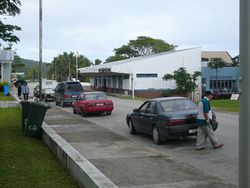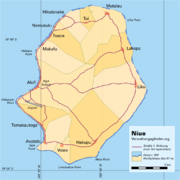Alofi
| Alofi |
| — City — |
|
Alofi street scene |
|
Location of Alofi (star). |
|
Administrative divisions of Niue with Alofi on the western side of the island. |
| Country |
Niue |
| Village |
Alofi North and Alofi South |
| Government |
| - Assemblyman of Alofi North |
Vaiga Tukuitoga[1] |
| - Assemblyman of Alofi South |
Dalton Tagelagi[2] |
| Area |
| - Area of both Alofi North and Alofi South |
46.48 km2 (17.9 sq mi) |
| Elevation[3] |
21 m (69 ft) |
| Population (2006)[4] |
| - Total |
581 |
| - Density |
12.5/km2 (32.46/sq mi) |
| - Alofi North |
147 |
| - Alofi South |
434 |
| Resident Population[5] |
| - Residents (Alofi North) |
143 |
| - Visitors (Alofi North) |
4 |
| - Resident (Alofi South) |
411 |
| - Visitor (Alofi South) |
23 |
| Time zone |
UTC-11 (UTC-11) |
| Area code(s) |
+683 |
| Alofi |
| Climate chart () |
| J |
F |
M |
A |
M |
J |
J |
A |
S |
O |
N |
D |
|
|
|
|
|
|
|
|
|
|
|
|
|
| average max. and min. temperatures in °C |
| precipitation totals in mm |
| source: Weatherbase[3] |
|
| Imperial conversion |
| J |
F |
M |
A |
M |
J |
J |
A |
S |
O |
N |
D |
|
|
|
|
|
|
|
|
|
|
|
|
|
| average max. and min. temperatures in °F |
| precipitation totals in inches |
|
- See Alofi Island for the island part of Wallis and Futuna.
Alofi is the capital city of the Pacific Ocean nation of Niue. It has a population of 581 (census of 2006). It consists of the two villages Alofi North (pop. 147) and Alofi South, where the government headquarters are located. (pop. 434).[4]
It is located at the centre of Alofi Bay on the west coast of the island, close to the only break in the coral reef that surrounds Niue. The bay stretches for 30% of the island's length (about seven kilometres) from Halagigie Point in the south to Makapu Point in the north. It is also notable that Alofi contains the world's largest toothbrush fence.
In January 2004, Niue was hit by the fierce tropical storm Cyclone Heta which killed two people and did extensive damage to the entire island. Many of Alofi's buildings were destroyed, including the hospital. Government buildings were shifted to a less exposed site 3 km inland from the west coast, named Fonuakula, after the storm.[6] This site is still within the village boundaries of Alofi South.
Notes
References
- East-West Center (2009-01-20). "Niue recovery at $23 million, Alofi to be relocated". East-West Center. East-West Center. http://www.reliefweb.int/rw/rwb.nsf/db900SID/ACOS-64BQXY?OpenDocument. Retrieved 2009-08-03.
- Kalauni, Hubert M (2008-06-10). "DECLARATION OF FINAL RESULT OF POLL FOR THE NIUE LEGISLATIVE ASSEMBLY GENERAL ELECTION ¶ SATURDAY 7 JUNE 2008" (PDF). Government of Niue. Alofi, Niue. p. 2. http://www.gov.nu/Documents/Declaration%20of%20GE2008%20Final%20Result18.pdf. Retrieved 2009-08-03.
- NZ Ministry of Foreign Affairs and Trade (2009-06-22). "Niue - Country Information Paper - NZ Ministry of Foreign Affairs and Trade". NZ Ministry of Foreign Affairs and Trade. http://www.mfat.govt.nz/Countries/Pacific/Niue.php. Retrieved 2009-08-03.
- Siosikefu, Margaret Hagen; Haberkorn, Gerald (2008), written at Auckland, New Zealand (PDF), Niue population profile based on 2006 census of population and housing: a guide for planners and policy-makers, Nouméa, New Caledonia: Secretariat of the Pacific Community, pp. 4–5, AACR2 304.609 9626, ISBN 978-982-00-0235-7, archived from the original on 2009-08-03, http://www.webcitation.org/5il4HDP14, retrieved 2009-08-03
- "Weatherbase: Historical Weather for Alofi, Niue". Weatherbase. 2009. http://www.weatherbase.com/weather/weatherall.php3?s=22819&refer=&units=metric. Retrieved 2009-08-03.
External links
|
Capitals of Oceania |
|
| Capitals of non-sovereign territories shown in SmallCaps |
|
| Australasia |
Melanesia |
Micronesia |
Polynesia |
|
|
|
|
|
Adamstown, Pitcairn Islands10
Alofi, Niue
Apia, Samoa
Avarua, Cook Islands5
Funafuti, Tuvalu
Hanga Roa, Easter Island9
Honolulu, Hawaii8
Mata-Utu, Wallis and Futuna6
Nukuʻalofa, Tonga
Pago Pago, American Samoa7
Papeete, French Polynesia6
|
|
|
| 1 Often included in Polynesia. 2 Often included in Southeast Asia. 3 Often included in Australasia. 4 Territory of Australia. 5 In free association with New Zealand. 6 Overseas collectivity of France. 7 Insular area of the United States. 8 U.S. state. 9 Territory of Chile. 10 Overseas Territory of the United Kingdom. |
|
|
Villages of Niue |
|
| Motu (northern area) |
Makefu • Tuapa • Namukulu • Hikutavake • Toi • Mutalau • Lakepa • Liku
|
 |
|
| Tafiti (southern area) |
Hakupu • Vaiea • Avatele • Tamakautoga • Alofi South • Alofi North
|
|


